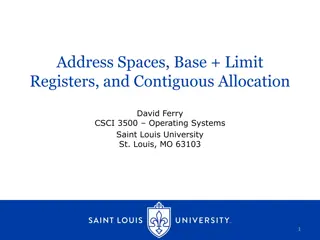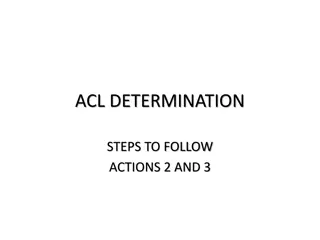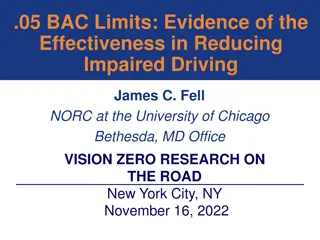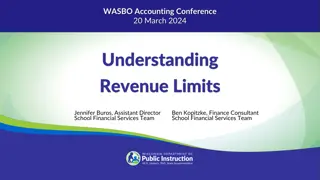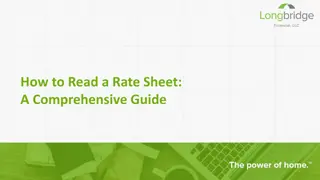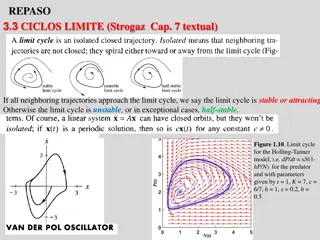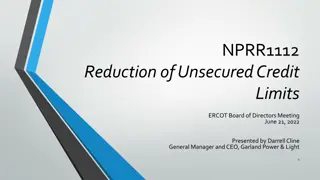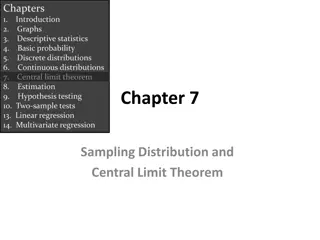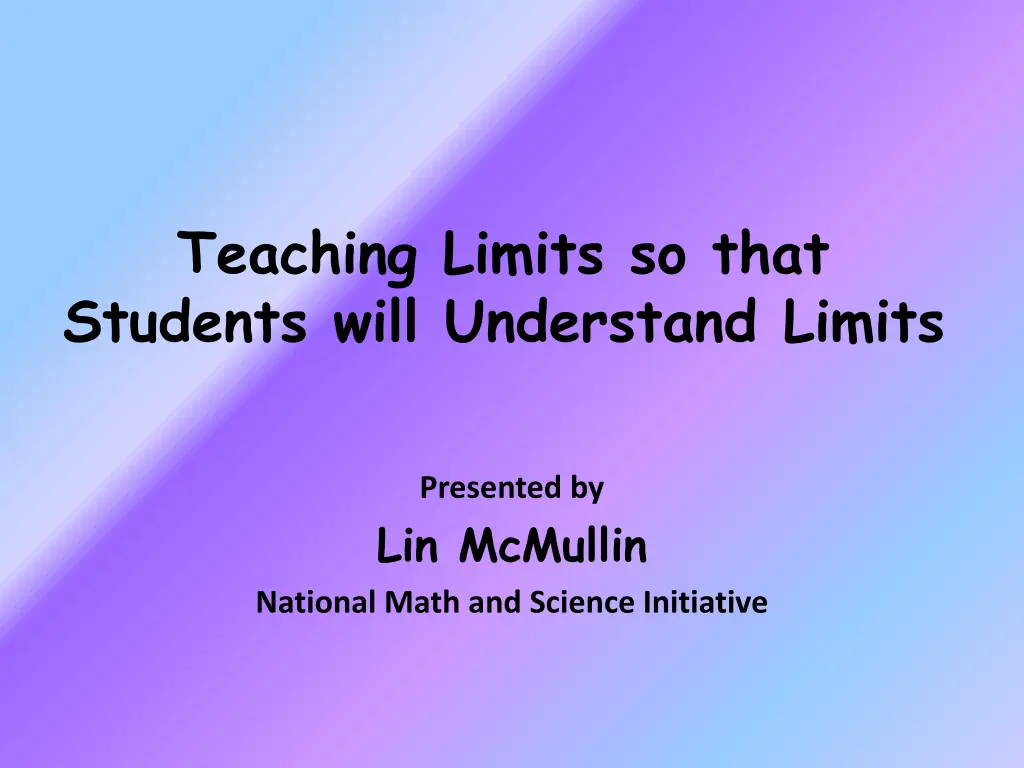
Understanding Limits and Asymptotes in Mathematics
Learn about limits, continuity, asymptotes, and the area problem in mathematics with a focus on understanding key concepts presented by Lin McMullin from the National Math and Science Initiative. Explore the behavior of functions near specific values, the concept of approaching infinity, and the relationship between secant lines and tangent lines. Gain insights into how functions behave as x approaches certain values and how to calculate areas using rectangles.
Download Presentation

Please find below an Image/Link to download the presentation.
The content on the website is provided AS IS for your information and personal use only. It may not be sold, licensed, or shared on other websites without obtaining consent from the author. If you encounter any issues during the download, it is possible that the publisher has removed the file from their server.
You are allowed to download the files provided on this website for personal or commercial use, subject to the condition that they are used lawfully. All files are the property of their respective owners.
The content on the website is provided AS IS for your information and personal use only. It may not be sold, licensed, or shared on other websites without obtaining consent from the author.
E N D
Presentation Transcript
Teaching Limits so that Students will Understand Limits Presented by Lin McMullin National Math and Science Initiative
Continuity + + 3 2 4 6 x x x ( ) f x = 2 x What happens at x = 2? What is f(2)? What happens near x = 2? f(x) is near 3 What happens as x approaches 2? f(x) approaches 3
Asymptotes 1 ( ) = g x ( ) 2 1 x What happens at x = 1? What happens near x = 1? As x approaches 1, g increases without bound, or g approaches infinity. As x increases without bound, g approaches 0. As x approaches infinity g approaches 0.
x x-1 1/(x-1)^2 Asymptotes 0.9 -0.1 100.00 0.91 -0.09 123.46 0.92 -0.08 156.25 1 0.93 -0.07 204.08 ( ) = g x 0.94 -0.06 277.78 ( ) 2 1 x 0.95 -0.05 400.00 0.96 -0.04 625.00 0.97 -0.03 1,111.11 0.98 -0.02 2,500.00 0.99 -0.01 10,000.00 1 0 Undefined 1.01 0.01 10,000.00 1.02 0.02 2,500.00 1.03 0.03 1,111.11 1.04 0.04 625.00 1.05 0.05 400.00 1.06 0.06 277.78 1.07 0.07 204.08 1.08 0.08 156.25 1.09 0.09 123.46 1.10 0.1 100.00
Asymptotes x x-1 1/(x-1)^2 1 ( ) = g x 1 0 Undefinned ( ) 2 1 x 2 1 1 5 4 0.25 10 9 0.01234567901234570 50 49 0.00041649312786339 100 99 0.00010203040506071 500 499 0.00000401604812832 1,000 999 0.00000100200300401 10,000 9999 0.00000001000200030 100,000 99999 0.00000000010000200 1,000,000 999999 0.00000000000100000 10,000,000 9999999 0.00000000000001000 100,000,000 99999999 0.00000000000000010
The Area Problem ( ) ( ) j x x x = = + = 2 1 h x x 0 = 1 3 What is the area of the outlined region? As the number of rectangles increases with out bound, the area of the rectangles approaches the area of the region.
The Tangent Line Problem What is the slope of the black line? As the red point approaches the black point, the red secant line approaches the black tangent line, and The slope of the secant line approaches the slope of the tangent line.
As x approaches 1, (5 2x) approaches ? 5 2x x 0.90 3.20 0.91 3.18 0.92 3.16 0.93 3.14 0.94 3.12 0.95 3.10 f(x) within 0.16 units of 3 x within 0.08 units of 1 f(x) within 0.08 units of 3 x within 0.04 units of 1 0.96 3.08 0.97 3.06 0.98 3.04 0.99 3.02 1.00 3.00 1.01 2.98 1.02 2.96 1.03 2.94 1.04 2.92 1.05 2.90 1.06 2.88 1.07 2.86 1.08 2.84 1.09 2.82
( ) lim 5 x 2 x 3 = 1 1 x 2 2 2 x 2 2 x 5 2 3 x ( ) 5 2 3 x ( ) f x L
( ) lim 5 x 2 x 3 = 1 ( ) 5 2 3 x or + 3 5 2 3 x Graph + 1 or 1 1 x x 2 2 2
( ) lim 5 x 2 x 3 = 1 = = = 4 2
The Definition of Limit at a Point When the values successively attributed to a variable approach indefinitely to a fixed value, in a manner so as to end by differing from it as little as one wishes, this last is called the limit of all the others. Augustin-Louis Cauchy (1789 1857)
The Definition of Limit at a Point ( ) x = lim x if, and only if, for any number 0 f L a ( ) there is a number 0 such t hat ( ) ( ) f x if 0 , then x a L Karl Weierstrass (1815 1897)
The Definition of Limit at a Point ( ) x = lim x if, and only if, for any number 0 f L a ( ) there is a number 0 such t hat ( ) ( ) f x if 0 , then x a L ( ) f x = lim x if, and only if, for any number 0 L a ( ) + there is a numb er 0 and such t hat x a ( ) ( ) ( ) f x + i f , then a x a L L Karl Weierstrass (1815 1897)
Footnote: The Definition of Limit at a Point ( ) = lim x 0 0 such that af x L ( ) f x , whenever 0 x a L
Footnote: The Definition of Limit at a Point ( ) = lim x 0 0 such that af x L ( ) f x x a , whe never 0 L
( ) lim 5 x 2 x 3 = 1 5 2x x 0.90 3.20 0.91 3.18 0.92 3.16 0.93 3.14 0.94 3.12 0.95 3.10 f(x) within 0.16 units of 3 x within 0.08 units of 1 f(x) within 0.08 units of 3 x within 0.04 units of 1 0.96 3.08 0.97 3.06 0.98 3.04 0.99 3.02 1.00 3.00 1.01 2.98 1.02 2.96 1.03 2.94 1.04 2.92 1.05 2.90 1.06 2.88 1.07 2.86 1.08 2.84 1.09 2.82
( ) lim 5 x 2 x 3 = 1 ( ) f x L ( ) 5 2 3 x 5 2 3 x 2 2 x 2 2 x 1 x 2
lim x x 9 2 = 3 2 9 x + 3 3 x x
lim x x 9 2 = 3 2 9 x + 3 3 x x = + Near 3, specifically in (2,4), 5 3 7 x x
lim x x 9 2 = 3 2 9 x + 3 3 x x = + Near 3, specifically in (2,4), 5 3 7 x x 7 3 x 3 x 7
lim x x 9 2 = 3 2 9 x + 3 3 x x = + Near 3, specifically in (2,4), 5 3 7 x x 7 3 x 3 x 7 ( ) = the smaller of 1 and 7 Graph
Length of Blue Arc = | x - a | lim sin( ) x a x sin( ) a = Length of Red Segment = | sin(x) - sin(a) | Therefore, | sin(x) - sin(a) | < | x - a | (0,1) (cos x, sin x) a + delta (cos a, sin a) sin x a - delta x in radians sin a (1, 0) Graph
One-sided Limits ( ) f x = lim x if, and only if, for any number 0 L + a ( ) there is a number 0 such that ( ) ( ) f x x a if 0 , then L ( ) f x = lim x if, and only if, for any number 0 L a ( ) there is a number 0 such that ( ) hen f x ( ) if 0 , t a x L
Limits Equal to Infinity ( ) f x = lim x if, and only if, for any number 0 M a ( ) there is a number such that ( ) ( ) ( ) f x ( ) f x x a if 0 , then M M Graphically this is a vertical asymptote ( ) = lim x if, and only if, for any number 0 af x M ( ) , then there is a number such that ( ) ( ) f x if 0 x a M
Limit as x Approaches Infinity ( ) f x = lim x if, and only if, for any number 0 L there is a number 0 suc h that M ( ) f x if , then x M L Graphically, this is a horizontal a sym t p ote ( ) f x = lim x if, and only if, for any number 0 L there is a number 0 such that M ( ) f x if , then x M L
Limit Theorems Almost all limit are actually found by substituting the values into the expression, simplifying, and coming up with a number, the limit. The theorems on limits of sums, products, powers, etc. justify the substituting. Those that don t simplify can often be found with more advanced theorems such as L'H pital's Rule
The Area Problem ( ) ( ) j x x x = = + = 2 1 h x x 0 = 1 3
The Area Problem ( ) h x b a n ( ) j x = = + 2 length 1 2 n x 3 1 n = = = width ( ) 2 ,1 ( ) 3 ,...,1 ( ) n + + + + x-coordinates = 1,1 ,1 2 n 2 n 2 n 2 n ( )( ) n ( ) 2 + + Area 1 1 i 2 n 2 n = 1 i ( )( ) 32 3 n ( ) 2 + + = Area =lim 1 1 i 2 n 2 n n = 1 i
The Area Problem ( )( ) n n n n ( ) 2 + + = 2 lim + + 2 lim i 1 1 lim n lim n i i i 2 n 2 n 2 n 2 n 4 n 2 n 4 n 2 n = = = = 1 1 1 1 i i i i n n n = + + 2 lim n 1 lim n lim n i i 8 n 8 n 4 n 2 3 = = = 1 + 1 1 i i i ( ) ( )( 6 ) + 1 2 + + 1 1 n n n n n = + lim n lim n lim n n 8 n 8 n 4 n 2 2 3 4 4 = + + = 8 3 32 3
The Tangent Line Problem As x P T ( ) ( ) 0 + + , P a x f a x slope f a PT + + m ( ) x ( ) f a a x m ( ) ( ) f a ( ) + f a x a ( ) ( ) , T a f a x ( ) f a ( ) = + x a y m
The Tangent Line Problem As x P T 0 ( ) ( ) + + , P a x f a x slope f PT + m ( ) x ( ) f a a a x ( ) a f ( ) ( ) ( ) f a + a + f a x ( ) ( ) , T a f a x ( ) f a ( )( a ) f = + x a y
Lin McMullin National Math and Science Initiative 325 North St. Paul St. Dallas, Texas 75201 214 665 2500 lmcmullin@NationalMathAndScience.org www.LinMcMullin.net Click: AP Calculus
Lin McMullin lmcmullin@NationalMathAndScience.org www.LinMcMullin.net Click: AP Calculus
= Let ( ) x ( ) a x a sin sin ( ) sin ( ) a x a sin sin x ( ) x ( ) a = limsin x a
( ) lim 5 x 2 x 3 = 1 ( ) = lim x if, and only if, af x L ( ) f x L for any number number 0 there is a 0 such that if ( ) ( ) ( ) f x x a 0 , then L ( ) x a
The Tangent Line Problem As x P T ( ) ( ) + + 0 , P a x f a x slope f a PT + + m ( ) x ( ) f a a x m ( ) ( ) f a + f a x ( ) a ( ) ( ) , T a f a x ( ) f a ( ) = + x a y m


